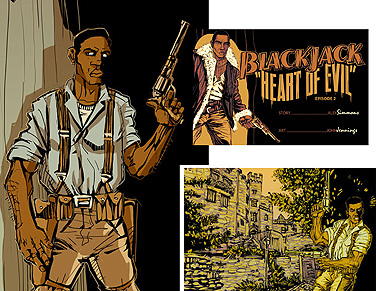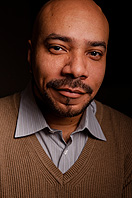Close Up
The art and activism of John Jennings

John Jennings is a regular contributor to the weekly Web adventures of “Black Jack, Heart of Evil,” a noir-ish comic. Created by Alex Simmons, Black Jack is a black soldier of fortune who lives in the 1930s.
John Jennings is drawn to many projects, across many disciplines. He is a noted designer, illustrator, cartoonist, award-winning graphic novelist and curator. His work overlaps into American studies, African American studies, design history, media studies, sociology, women and gender studies, and literature.
After eight years on the graphic design faculty at his alma mater, the University of Illinois-Urbana-Champaign (MA ‘95, MFA ’97), Jennings joined UB’s Department of Visual Studies last fall as an associate professor.
His research and teaching focus is on the analysis, explication and disruption of African American stereotypes in popular visual media. His attack is with pen and words, panel by panel, page by page, exhibit by exhibit.
“I’m really serious about a lot of different things. I feel like I have a gift that I like to share with people, to collaborate and build knowledge together,” he says. “It’s about being a teacher and an eternal student that keeps me grounded.”
Jennings has made a visual impact in publishing, on the Web and in galleries around the world with graphic novels, historical perspectives and exhibitions, all celebrating the work of artists like himself, including veteran artists and those relatively new to the field. His Humanities Institute lecture in November in Clemens Hall on the history of black comics drew a standing-room crowd. He has delivered such lectures from Harvard to the University of California-Berkeley.
Growing up in rural Mississippi, young Jennings became steeped in the classics from Poe, Hawthorne and Twain, plus a heavy supply of mythology courtesy of his English major mother, who kept a library of books on mythology. In addition, his grandmother was a teller of tall tales and his uncle was an artist.
“One day, my mother brings home a comic book, The Mighty Thor, created by Jack Kirby of Marvel Comics—basically a pop culture version of the Norse mythology,” he recalls. “I fell in love with it. I loved that kind of storytelling. I began drawing and never stopped.”
He majored in commercial art at Jackson State University (BA ’93), worked at the local newspaper, The Clarion-Ledger, went to graduate school and then came back to Jackson State to begin his academic career.
Jennings’s first big success came in 2008 with publication of his graphic novel, “The Hole: Consumer Culture,” a science fiction/horror story about the buying and selling of race in America, the simultaneous worship and degradation of African Americans in popular culture and the tearing down of physical and psychological boundaries.
The graphic novel won the 2009 Glyph Comics Award—which recognizes the best in comics made by, for and about people of color—for Rising Star for Independent Publishing and was nominated for two other Glyph awards for outstanding work in the comics medium that pertains to the depictions and concerns of African Americans. It has been used as required reading in various university-level media studies and American studies classes around the country, including at Ohio State, Dartmouth and UC-Berkeley.
Previously a comic that Jennings co-created to bring attention to the struggles of individuals impacted by Hurricane Katrina was nominated for 2007 Glyph awards in three categories: best male character, best writer and story of the year.
Jennings has said that graphic novels became central to his graduate studies and now to his research into alternate types of literacy.
His contribution to the 2010 book “Black Comix: African American Independent Comics, Art and Culture” celebrates the heritage and underrepresented artists of the profession. The book prompted the creation of The Chairman’s Award category in the Glyph Comics Awards for a special publication that helps further the agenda of the Black Age of Comics.
This cause also is a forum on a website he co-founded, Eye Trauma Comix), an online anthology of sequential artists, activists and curators who seek to expand the public’s perception of the comics medium.
Jennings also has spotlighted African American comic-book creators and legendary comics masters in several exhibits he has co-curated at various galleries around the country. In addition, he helped coordinate a show called The Souls of Black Manga at Doshisha University in Kyoto, Japan, in 2008.
He currently is consulting on Fantastic Blackness: The Art and Politics of the Black Superhero, a show that will open in February in Los Angeles. His original collaborative work with Stacey “Blackstar” Robinson will be featured in Black Kirby, a show about Jack Kirby’s influence on black comics to open at Jackson State University next fall.
As for his drawing pursuits, the 41-year-old Jennings is a regular contributor to the weekly Web adventures of Black Jack, Heart of Evil, a noir-ish comic.
He also is in the process of adapting “On the Road,” a work by Nnedi Okorafor, a Nigerian-American writer of fantasy and science fiction, and winner of the 2011 World Fantasy Award for her novel “Who Fears Death.” Jennings’ adaptation will turn photos of model Nicole Williams taken by photographer Tarji Smedley into a graphic storyboard.
“It’s a dark fantasy piece about a Nigerian-American woman who, while in Africa, is forced to deal with certain ancestral spirits interacting with her,” he says.
Jennings is settling into his role at UB, impressed with the culture of the school and the collaborative spirit. He likes Buffalo as well, living in an apartment downtown and commuting to school by Metro.
“I love the food and people,” he says. “It’s a beer town, too, which I really appreciate. How do they put it—Buffalo is a drinking town with a sports problem.”
Could Buffalo have potential as a locale in a future graphic adventure? Who knows what lurks within the imaginative powers of John Jennings?


Reader Comments